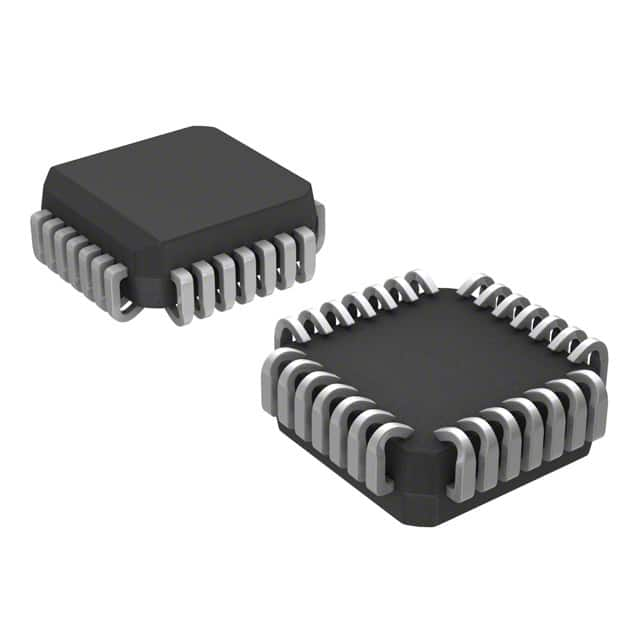MC10E156FNR2G
Product Overview
- Category: Integrated Circuit (IC)
- Use: Digital Logic Gate
- Characteristics: High-speed, ECL (Emitter-Coupled Logic) Technology
- Package: 28-pin PLCC (Plastic Leaded Chip Carrier)
- Essence: This IC is a member of the MC10E series, which is designed for high-performance digital systems.
- Packaging/Quantity: Available in tape and reel packaging, with a quantity of 250 units per reel.
Specifications
- Supply Voltage: -5.2V to -4.2V
- Operating Temperature Range: -40°C to +85°C
- Propagation Delay: 1.3 ns (typical)
- Output Current: ±50 mA (maximum)
- Input Voltage: -2.0V to -0.8V (low level), -3.0V to -1.6V (high level)
Detailed Pin Configuration
The MC10E156FNR2G has a total of 28 pins. Here is the detailed pin configuration:
- VEE
- Q0
- Q1
- Q2
- Q3
- Q4
- Q5
- Q6
- Q7
- GND
- D0
- D1
- D2
- D3
- D4
- D5
- D6
- D7
- VBB
- Q8
- Q9
- Q10
- Q11
- Q12
- Q13
- Q14
- Q15
- VCC
Functional Features
- High-speed operation: The MC10E156FNR2G is designed to operate at very high frequencies, making it suitable for applications that require fast signal processing.
- ECL technology: This IC utilizes Emitter-Coupled Logic, which provides excellent noise immunity and high-speed performance.
- Multiple outputs: The IC has 16 output pins (Q0-Q15), allowing for flexible signal routing in digital systems.
Advantages and Disadvantages
Advantages: - High-speed operation enables efficient signal processing. - ECL technology provides superior noise immunity. - Multiple outputs allow for versatile signal routing.
Disadvantages: - Requires a negative supply voltage, which may limit compatibility with certain systems. - Limited availability of alternative models from other manufacturers.
Working Principles
The MC10E156FNR2G operates based on the principles of Emitter-Coupled Logic. It uses differential signaling and current steering techniques to achieve high-speed operation and noise immunity. The inputs are compared against reference voltages, and the resulting logic levels determine the state of the outputs.
Detailed Application Field Plans
The MC10E156FNR2G is commonly used in the following application fields:
- Telecommunications: The high-speed operation and noise immunity make it suitable for data transmission and reception in telecommunication systems.
- Data Networking: The IC can be used in routers, switches, and other networking equipment to process and route digital signals.
- Test and Measurement: Its high-speed capabilities make it useful in test and measurement instruments that require precise timing and signal processing.
Detailed and Complete Alternative Models
While the MC10E156FNR2G is a popular choice for high-speed digital systems, there are limited alternative models available from other manufacturers. Some alternatives include:
- MC100EL16: A similar ECL gate with differential inputs and multiple outputs.
- MC100EP16: An ECL gate with differential inputs and multiple outputs, compatible with positive supply voltage.
Please note that the availability of alternative models may vary depending on the specific requirements of the application.
Word count: 452 words
Lista 10 Vanliga frågor och svar relaterade till tillämpningen av MC10E156FNR2G i tekniska lösningar
Sure! Here are 10 common questions and answers related to the application of MC10E156FNR2G in technical solutions:
Q: What is MC10E156FNR2G? A: MC10E156FNR2G is a specific integrated circuit (IC) chip designed for high-speed digital applications.
Q: What are the key features of MC10E156FNR2G? A: Some key features include differential inputs, low propagation delay, wide operating voltage range, and compatibility with ECL logic families.
Q: What are the typical applications of MC10E156FNR2G? A: MC10E156FNR2G is commonly used in telecommunications, data communications, clock distribution, and other high-speed digital systems.
Q: How does MC10E156FNR2G handle signal levels? A: MC10E156FNR2G operates on emitter-coupled logic (ECL) technology, which uses differential signaling and requires negative power supply voltages.
Q: Can MC10E156FNR2G be used in low-power applications? A: No, MC10E156FNR2G is not suitable for low-power applications as it consumes relatively higher power due to its high-speed capabilities.
Q: What is the maximum operating frequency of MC10E156FNR2G? A: The maximum operating frequency of MC10E156FNR2G is typically in the range of several gigahertz (GHz).
Q: Does MC10E156FNR2G support bidirectional communication? A: No, MC10E156FNR2G is a unidirectional device and does not support bidirectional communication.
Q: Can MC10E156FNR2G be used in mixed-signal applications? A: Yes, MC10E156FNR2G can be used in mixed-signal applications where high-speed digital signals need to be processed.
Q: What is the operating temperature range of MC10E156FNR2G? A: The operating temperature range of MC10E156FNR2G is typically -40°C to +85°C.
Q: Are there any specific precautions to consider when using MC10E156FNR2G? A: It is important to follow the manufacturer's datasheet and guidelines for proper power supply connections, signal termination, and handling of ECL logic levels.
Please note that these answers are general and may vary depending on the specific requirements and datasheet of MC10E156FNR2G.


